Analyzing the Performance and Control of a Hydronic Pavement System in a District Heating Network
Abstract
1. Introduction
2. Method
2.1. The Simulation Software ANSYS
2.2. The Optimization Software MODEST
3. The Studied Scenarios
Scenarios and Specifics
- Scenario R: Reference scenario, business as usual
- Scenario 1: The HPS system shuts down at temperatures lower than −10 °C
- Scenario 2: The HPS system shuts down at temperatures lower than −5 °C
4. Computational Setup and Numerical Procedure
4.1. Parameters and Properties of the HPS Simulation Model
- Weather properties regarding temperature, precipitation, solar irradiation, and wind.
- Material properties regarding density, thermal conductivity, and specific heat capacity.
- Heat transfer equations regarding conductivity, convection, and radiation.
- Operational parameters.
Limitations and Comments on the Model
4.2. Parameters and Properties of the DHC System’s Optimization Model
5. Results
5.1. Comparing Models of the HPS and DHC System to Actual System Performance
5.2. Performance of the HPS and Energy Use of the Studied Scenarios
5.3. Evaluation of the Impact the HPS Has on the DHC System
6. Discussion
6.1. The Scenarios and Modeling of the HPS
6.2. Performance of the HPS
6.3. The impact of the HPS on the DHC System
7. Conclusions
- The study indicates that the HPS is suitable for the use of return temperatures in a DHC system. An HPS could further decrease the return temperature, thereby potentially increasing the efficiency of the DHC system. Furthermore, in a future DHC system with lower supply temperatures, it is also desirable to achieve lower return temperatures to maintain an efficient DHC system.
- A control strategy that shuts down the HPS at temperatures below −10 °C results in a 10% energy saving, avoidance of use during the top 50 h of peak demand in the DHC system, reduced use of fossil fuel and a 25% reduction in local GHG emissions, whilst maintaining sufficient performance of the HPS.
- Utilizing HPS connected to a DHC system which has CHP can potentially result in increased electricity production. This generates a positive effect and reduction on the global GHG emissions if a coal condensing power plant is regarded as the marginal production unit in the European electricity market. In a future fossil-free production of DHC, the generated electricity will fully derive from renewable resources. This will improve the impact an HPS has on the GHG emissions even further.
Author Contributions
Funding
Acknowledgments
Conflicts of Interest
References
- Byggnadsstyrelsen. Markvärme; KBS Rapport; Byggnadsstyrelsen: Stockholm, Sweden, 1976. [Google Scholar]
- Lund, J.W.; Boyd, T.L. Geothermal direct-use in the United States update: 1995–1999. In Proceedings of the Proceedings World Geothermal Congress 2000, Tohoku, Japan, 28 May–10 June 2000; Geo-Heat Center, Oregon Institute of Technology Klamath Falls: Kyushu, Japan, 2000; pp. 297–305. [Google Scholar]
- Lund, J.W. Reconstruction of a pavement geothermal deicing system. Geo-Heat Cent. Q. Bull. 1999, 20, 14–17. [Google Scholar]
- American Society of Heating, Refrigerating and Air-Conditioning Engineers. 2011 ASHRAE Handbook: Heating, Ventilating, and Air-Conditioning Applications; ASHRAE: Atlanta, GA, USA, 2011; ISBN 9781936504077. [Google Scholar]
- Mensah, K.; Choi, J.M. Review of technologies for snow melting systems. J. Mech. Sci. Technol. 2015, 29, 5507–5521. [Google Scholar] [CrossRef]
- Pan, P.; Wu, S.; Xiao, Y.; Liu, G. A review on hydronic asphalt pavement for energy harvesting and snow melting. Renew. Sustain. Energy Rev. 2015, 48, 624–634. [Google Scholar] [CrossRef]
- Lund, J.W.; Boyd, T.L. Direct utilization of geothermal energy 2015 worldwide review. Geothermics 2016, 60, 66–93. [Google Scholar] [CrossRef]
- Zwarycz, K. Snow Melting and Heating Systems Based on Geothermal Heat Pumps at Goleniow Airport, Poland; The United Nations University, Geothermal training programme: Reykjavik, Iceland, 2002. [Google Scholar]
- Shen, W.; Ceylan, H.; Gopalakrishnan, K.; Kim, S.; Taylor, P.C.; Rehmann, C.R. Life cycle assessment of heated apron pavement system operations. Transp. Res. Part D Transp. Environ. 2016, 48, 316–331. [Google Scholar] [CrossRef]
- Shen, W.; Gopalakrishnan, K.; Kim, S.; Ceylan, H. Assessment of Greenhouse Gas Emissions from Geothermal Heated Airport Pavement System. ISSN Int. J. Pavement Res. Technol. Int. J. Pavement Res. Technol. 1997, 88, 233–242. [Google Scholar]
- Shen, W.; Ceylan, H.; Gopalakrishnan, K.; Kim, S.; Nahvi, A. Sustainability Assessment of Alternative Snow-Removal Methods for Airport Apron Paved Surfaces; Federal Aviation Administration: Atlantic City, NJ, USA, 2017.
- Chi, Z.; Yiqiu, T.; Fengchen, C.; Qing, Y.; Huining, X. Long-term thermal analysis of an airfield-runway snow-melting system utilizing heat-pipe technology. Energy Convers. Manag. 2019, 186, 473–486. [Google Scholar] [CrossRef]
- Zhang, N.; Yu, X.; Li, T. Numerical Simulation of Geothermal Heated Bridge Deck. In Proceedings of the International Conference on Transportation Infrastructure and Materials (ICTIM 2017), Qingdao, China, 9–12 June 2017. [Google Scholar]
- Yu, X.; Zhang, N.; Pradhan, A.; Puppala, A.J. Geothermal Energy for Bridge Deck and Pavement Deicing—A Brief Review. In Proceedings of the Geo-Chicago 2016, Chicago, IL, USA, 14–18 August 2016; American Society of Civil Engineers: Reston, VA, USA, 2016; pp. 598–609. [Google Scholar]
- Swedish Energy Agency Annual Energy Statistics (Electricity, Gas and District Heating). Available online: http://www.scb.se/en0105-en (accessed on 18 April 2019).
- Gunnlaugsson, E.; Reykjavikur Baejarhals, O. District heating in Reykjavík; past–present–future. In Proceedings of the 30th Anniversary Workshop, Reykjavík, Iceland, 26 August 2008. [Google Scholar]
- Solaimanian, M.; Kennedy, T.W. Predicting Maximum Pavement Surface Temperature Using Maximum Air Temperature and Hourly Solar Radiation. Transp. Res. Rec. 1993, 1417, 1–11. [Google Scholar]
- Gustavsson, T.; Bogren, J.; Green, C. Road Climate in Cities:A Study of the Stockholm Area, South-East Sweden. Meteorol. Appl. 2001, 8, 481–489. [Google Scholar] [CrossRef]
- Andriopoulou, S. A Review on Energy Harvesting from Roads; [TSC-MT 12-017]; KTH Royal Institute of Technology: Stockholm, Sweden, 2012. [Google Scholar]
- National Research Council (US). Comparing Salt and Calcium Magnesium Acetate; National Research Council: Washington, DC, USA, 1991. [Google Scholar]
- Amrhein, C.; Strong, J.E.; Mosher, P.A. Effect of deicing salts on metal and organic matter mobilization in roadside soils. Environ. Sci. Technol. 1992, 26, 703–709. [Google Scholar] [CrossRef]
- Bäckström, M.; Karlsson, S.; Bäckman, L.; Folkeson, L.; Lind, B. Mobilisation of heavy metals by deicing salts in a roadside environment. Water Res. 2004, 38, 720–732. [Google Scholar] [CrossRef] [PubMed]
- Fischel, M. Evaluation of Selected Deicers Based on a Review of the Literature; Colorado Department of Transportation: Denver, CO, USA, 2001.
- Howard, K.W.F.; Haynes, J. Groundwater Contamination due to Road De-icing Chemicals - Salt Balance Implications. Geosci. Can. 1993, 20, 1–8. [Google Scholar]
- Kroening, S.; Ferrey, M. The Condition of Minnesota’s Groundwater, 2007–2011; Minnesota Pollution Control Agency: Saint Paul, MI, USA, 2013.
- Fay, L.; Shi, X. Environmental Impacts of Chemicals for Snow and Ice Control: State of the Knowledge. Water Air Soil Pollut. 2012, 223, 2751–2770. [Google Scholar] [CrossRef]
- Nevalainen Henaes, H. Impact on Society from Conventional Winter Road Maintenance and Ground Heating (sv: Samhällspåverkan vid Konventionell Vinterväghållning och Markvärme); Lunds University—Faculty of Engineering: Lund, Sweden, 2018. [Google Scholar]
- Adl-Zarrabi, B.; Mirzanamadi, R.; Johnsson, J. Hydronic pavement heating for sustainable ice-free roads. Transp. Res. Procedia 2016, 14, 704–713. [Google Scholar] [CrossRef]
- Nixon, W.A. Improved Cutting Edges for Ice Removal; Strategic Highway Research Program: Washington, DC, USA, 1993. [Google Scholar]
- Schyllander, J. Fotgängarolyckor: Statistik och Analys; Swedish Civil Contingencies Agency: Karlstad, Sweden, 2014.
- Carlsson, A.; Sawaya, B.; Kovaceva, J.; Andersson, M. Skadereducerande Effekt av Uppvärmda Trottoarer, Gång- och Cykelstråk (TRV 2016/19843); Chalmers University of Technology: Gothenburg, Sweden, 2018. [Google Scholar]
- Öberg, G.; Arvidsson, A.K. Injured Pedestrians: The Cost of Pedestrian Injuries Compared to Winter Maintenance Costs; Swedish National Road and Transport Research Institute: Linköping, Sweden, 2012.
- Mattsson, A. Samhällsekonomiska Effekter av VinterväGhåLlning för GåEnde.: En Kostnads–Nyttoanalys av VinterväGhåLlning och GåNgtrafikanters Singelolyckor i Stockholms Stad; Linköping University: Linköping, Sweden, 2017. [Google Scholar]
- Xu, H.; Tan, Y. Modeling and operation strategy of pavement snow melting systems utilizing low-temperature heating fluids. Energy 2015, 80, 666–676. [Google Scholar] [CrossRef]
- Mirzanamadi, R. Ice Free Roads Using Hydronic Heating Pavement with Low Temperature Thermal Properties of Asphalt Concretes and Numerical Simulations; Chalmers University of Technology: Gothenburg, Sweden, 2017. [Google Scholar]
- Rees, S.J.; Spitler, J.D.; Xiao, X. Transient analysis of snow-melting system performance. ASHRAE Trans. 2002, 108 Pt 2, 406–423. [Google Scholar]
- Commission of the European communities. 20 20 by 2020 Europe’s Climate Change Opportunity; Commission of the European Communities: Brussels, Belgium, 2008. [Google Scholar]
- Reinfeldt, F.; Olofsson, M. Prop. 2008/09:163: En Sammanhållen Klimat- och Energipolitik; Government Office: Stockholm, Sweden, 2008. [Google Scholar]
- Löfven, S.; Baylan, I. Prop. 2017/18:228: Energipolitikens inriktning; Government Office: Stockholm, Sweden, 2018. [Google Scholar]
- Fossil free Sweden (sv: Fossilfritt Sverige). Roadmaps for Fossil Free Competitiveness—The Heating Sector (sv: Färdplan för Fossilfri Konkurrenskraft—Uppvärmningsbranschen); Fossil Free Sweden: Stockholm, Sweden, 2018. [Google Scholar]
- Kim, H.-J.; Yu, J.-J.; Yoo, S.-H.; Kim, H.-J.; Yu, J.-J.; Yoo, S.-H. Does Combined Heat and Power Play the Role of a Bridge in Energy Transition? Evidence from a Cross-Country Analysis. Sustainability 2019, 11, 1035. [Google Scholar] [CrossRef]
- Lake, A.; Rezaie, B.; Beyerlein, S. Review of district heating and cooling systems for a sustainable future. Renew. Sustain. Energy Rev. 2017, 67, 417–425. [Google Scholar] [CrossRef]
- Sayegh, M.A.; Danielewicz, J.; Nannou, T.; Miniewicz, M.; Jadwiszczak, P.; Piekarska, K.; Jouhara, H. Trends of European research and development in district heating technologies. Renew. Sustain. Energy Rev. 2016, 68, 1183–1192. [Google Scholar] [CrossRef]
- Lund, R.; Mathiesen, B.V. Large combined heat and power plants in sustainable energy systems. Appl. Energy 2015, 142, 389–395. [Google Scholar] [CrossRef]
- Stankeviciute, L.; Krook Riekkola, A. Assessing the development of combined heat and power generation in the EU. Int. J. Energy Sect. Manag. 2014, 8, 76–99. [Google Scholar] [CrossRef]
- Werner, S. International review of district heating and cooling. Energy 2017, 137, 617–631. [Google Scholar] [CrossRef]
- Sernhed, K.; Lygnerud, K.; Werner, S. Synthesis of recent Swedish district heating research. Energy 2018, 151, 126–132. [Google Scholar] [CrossRef]
- Djuric Ilic, D.; Dotzauer, E.; Trygg, L.; Broman, G. Introduction of large-scale biofuel production in a district heating system e an opportunity for reduction of global greenhouse gas emissions. J. Clean. Prod. 2014, 64, 552–561. [Google Scholar] [CrossRef]
- Helin, K.; Zakeri, B.; Syri, S.; Helin, K.; Zakeri, B.; Syri, S. Is District Heating Combined Heat and Power at Risk in the Nordic Area?—An Electricity Market Perspective. Energies 2018, 11, 1256. [Google Scholar] [CrossRef]
- Gadd, H.; Werner, S. Achieving low return temperatures from district heating substations. Appl. Energy 2014, 136, 59–67. [Google Scholar] [CrossRef]
- Lauenburg, P. Temperature optimization in district heating systems. Adv. Dist. Heat. Cool. Syst. 2016, 223–240. [Google Scholar] [CrossRef]
- Frederiksen, S.; Werner, S. District Heating and Cooling, 1st ed.; Studentlitteratur: Lund, Sweden, 2013; ISBN 9789144085302. [Google Scholar]
- Lund, H.; Werner, S.; Wiltshire, R.; Svendsen, S.; Thorsen, J.E.; Hvelplund, F.; Mathiesen, B.V. 4th Generation District Heating (4GDH): Integrating smart thermal grids into future sustainable energy systems. Energy 2014, 68, 1–11. [Google Scholar] [CrossRef]
- ANSYS Inc. ANSYS® WorkbenchTM, Release 18.0.; ANSYS® CFX®, ANSYS Inc.: Canonsburg, PA, USA, 2016. [Google Scholar]
- Division of Energy System at Linköping University. Converter; Linköping University: Linköping, Sweden, 2016. [Google Scholar]
- Henning, D. MODEST for Windows; IEI Energy Systems; Linköping University: Linköping, Sweden, 2014. [Google Scholar]
- Temam, R. Navier-Stokes Equations: Theory and Numerical Analysis; AMS Chelsea Pub: Amsterdam, The Netherlands, 2001; ISBN 0821827375. [Google Scholar]
- ANSYS Inc. ANSYS Documentation Release 18.0; ANSYS Inc.: Canonsburg, PA, USA, 2016. [Google Scholar]
- Henning, D. MODEST—An energy-system optimisation model applicable to local utilities and countries. Energy 1997, 22, 1135–1150. [Google Scholar] [CrossRef]
- Henning, D. Optimisation of Local and National Energy Systems: Development and Use of the MODEST Model; Division of Energy Systems, Department of Mechanical Engineering, Linköpings University: Linköping, Sweden, 1999; ISBN 9172193921. [Google Scholar]
- Åberg, M.; Widén, J.; Henning, D. Sensitivity of district heating system operation to heat demand reductions and electricity price variations: A Swedish example. Energy 2012, 41, 525–540. [Google Scholar] [CrossRef]
- Åberg, M.; Henning, D. Optimisation of a Swedish district heating system with reduced heat demand due to energy efficiency measures in residential buildings. Energy Policy 2011, 39, 7839–7852. [Google Scholar] [CrossRef]
- Lidberg, T.; Olofsson, T.; Trygg, L. System impact of energy efficient building refurbishment within a district heated region. Energy 2016, 106, 45–53. [Google Scholar] [CrossRef]
- Henning, D.; Trygg, L. Reduction of electricity use in Swedish industry and its impact on national power supply and European CO2 emissions. Energy Policy 2008, 36, 2330–2350. [Google Scholar] [CrossRef]
- Sundberg, G.; Orgen, J.; Odin, S. Project financing consequences on cogeneration: Industrial plant and municipal utility co-operation in Sweden. Energy Policy 2003, 31, 491–503. [Google Scholar] [CrossRef]
- Gebremedhin, A. The role of a paper mill in a merged district heating system. Appl. Therm. Eng. 2003, 23, 769–778. [Google Scholar] [CrossRef]
- Lund, R.; Ilic, D.D.; Trygg, L. Socioeconomic potential for introducing large-scale heat pumps in district heating in Denmark. J. Clean. Prod. 2016, 139, 219–229. [Google Scholar] [CrossRef]
- Amiri, S.; Henning, D.; Karlsson, B.G. Simulation and introduction of a CHP plant in a Swedish biogas system. Renew. Energy 2013, 49, 242–249. [Google Scholar] [CrossRef]
- Blomqvist, S.; Nyberg, S.; Energisystem, A. Modellering och Energieffektivisering av Befintligt Markvärmesystem; Linköping University: Linköping, Sweden, 2014. [Google Scholar]
- Swedish Meteorological and Hydrological Institutes SMHI’s Open Data. Available online: https://www.smhi.se/en/services/open-data/search-smhi-s-open-data-1.81004 (accessed on 14 March 2019).
- Hassn, A.; Chiarelli, A.; Dawson, A.; Garcia, A. Thermal properties of asphalt pavements under dry and wet conditions. Mater. Des. 2016, 91, 432–439. [Google Scholar] [CrossRef]
- Li, H.; Harvey, J.; Jones, D. Multi-dimensional transient temperature simulation and back-calculation for thermal properties of building materials. Build. Environ. 2013, 59, 501–516. [Google Scholar] [CrossRef]
- Shin, A.H.; Kodide, U. Thermal conductivity of ternary mixtures for concrete pavements. Cem. Concr. Compos. 2012, 34, 575–582. [Google Scholar] [CrossRef]
- Ohemeng, E.A.; Yalley, P.P.-K. Models for predicting the density and compressive strength of rubberized concrete pavement blocks. Constr. Build. Mater. 2013, 47, 656–661. [Google Scholar] [CrossRef]
- Ižvolt, L.; Dobeš, P. Test Procedure Impact for the Values of Specific Heat Capacity and Thermal Conductivity Coefficient. Procedia Eng. 2014, 91, 453–458. [Google Scholar] [CrossRef]
- Sundberg, J. Thermal Properties of Soil and Rock (sv: Termiska Egenskaper i jord och Berg); Swedish Geotechnical Institute (SGI): Linköping, Sweden, 1991; Volume 12. [Google Scholar]
- Luca, J.; Mrawira, D. New Measurement of Thermal Properties of Superpave Asphalt Concrete. J. Mater. Civ. Eng. 2005, 17, 72–79. [Google Scholar] [CrossRef]
- Uponor Uponor surface heating system (sv: Uponor ytvärmesystem). Heating, Ventilation and Sanitation Manual; Uponor AB: Västerås, Sweden, 2018; pp. 547–565. [Google Scholar]
- Swedish Meteorological and Hydrological Institute; Swedish Radiation Safety Authority; Swedish Environmental Protection Agency STRÅNG. A Mesoscale Model for Solar Radiation. Available online: http://strang.smhi.se/ (accessed on 26 April 2019).
- Santamouris, M. (Matheos) Energy and Climate in the Urban Built Environment—Chapter 11 Appropiate Materials for the Urban Environment; Santamouris, M., Ed.; James & James: Athens, Greece, 1999; ISBN 9781873936900. [Google Scholar]
- Brown, R.D.; Gillespie, T.J. Microclimatic Landscape Design: Creating Thermal Comfort and Energy Efficiency; J. Wiley & Sons: Guelph, ON, Canada, 1995; ISBN 0471056677. [Google Scholar]
- Çengel, Y.A.; Turner, R.H.; Cimbala, J.M. Fundamentals of Thermal-Fluid Sciences; McGraw Hill Higher Education: New York, NY, USA, 2008; ISBN 9780071266314. [Google Scholar]
- Holman, J.P.; Jack, P. Heat Transfer; McGraw Hill Higher Education: New York, NY, USA, 2010; ISBN 9780073529363. [Google Scholar]
- Storck, K.; Karlsson, M.; Andersson, I.; Renner, J.; Lloyd, D. Formelsamling i Termo- och Fluiddynamik; Linkoping University: Linköping, Sweden, 2009. [Google Scholar]
- Lindeburg, M.R. Civil Engineering Reference Manual for the PE Exam, Appendices A-45, 9th ed.; Professional Publications: Belmont, CA, USA, 2003; ISBN 9781888577952. [Google Scholar]
- Dobre, R.-G.; Gaitanaru, D.S. Snowmelt modelling aspects in urban areas. Procedia Eng. 2017, 209, 127–134. [Google Scholar] [CrossRef]
- Nuijten, A.D.W.; Høyland, K.V. Comparison of melting processes of dry uncompressed and compressed snow on heated pavements. Cold Reg. Sci. Technol. 2016, 129, 69–76. [Google Scholar] [CrossRef]
- Boverket Öppna Data—Dimensionerande Vinterutetemperatur (DVUT 1981-2010) för 310 orter i Sverige. Available online: https://www.boverket.se/sv/om-boverket/publicerat-av-boverket/oppna-data/dimensionerande-vinterutetemperatur-dvut-1981-2010/ (accessed on 28 Junuary 2018).
- Blomqvist, S.; La Fleur, L.; Amiri, S.; Rohdin, P.; Ödlund, L. The Impact on System Performance When Renovating a Multifamily Building Stock in a District Heated Region. Sustainability 2019, 11, 2199. [Google Scholar] [CrossRef]
- Swedenergy (sv. Energiföretagen Sverige). Överenskommelse i Värmemarknadskommittén 2018; Swedenergy: Stockholm, Sweden, 2018. [Google Scholar]
- Gode, J.; Martinsson, F.; Hagberg, L.; Öman, A.; Höglund, J.; Palm, D. Miljöfaktaboken 2011—Estimated Emission Factors for Fuels, Electricity, Heat and Transport in Sweden (Sv: Uppskattade Emissionsfaktorer för Bränslen, el, värme och Transporter); Värmeforsk Service AB: Stockholm, Sweden, 2011; ISBN 1653-1248. [Google Scholar]
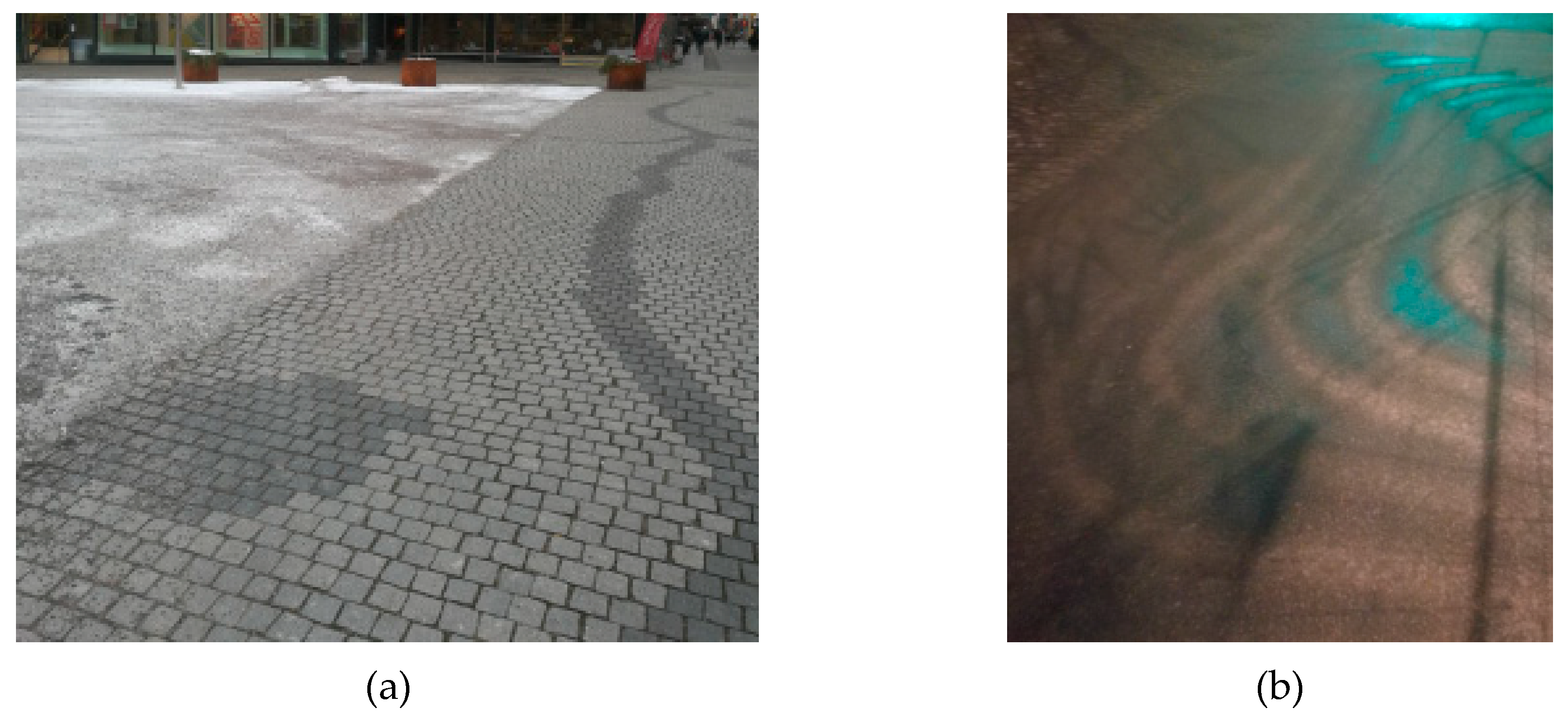

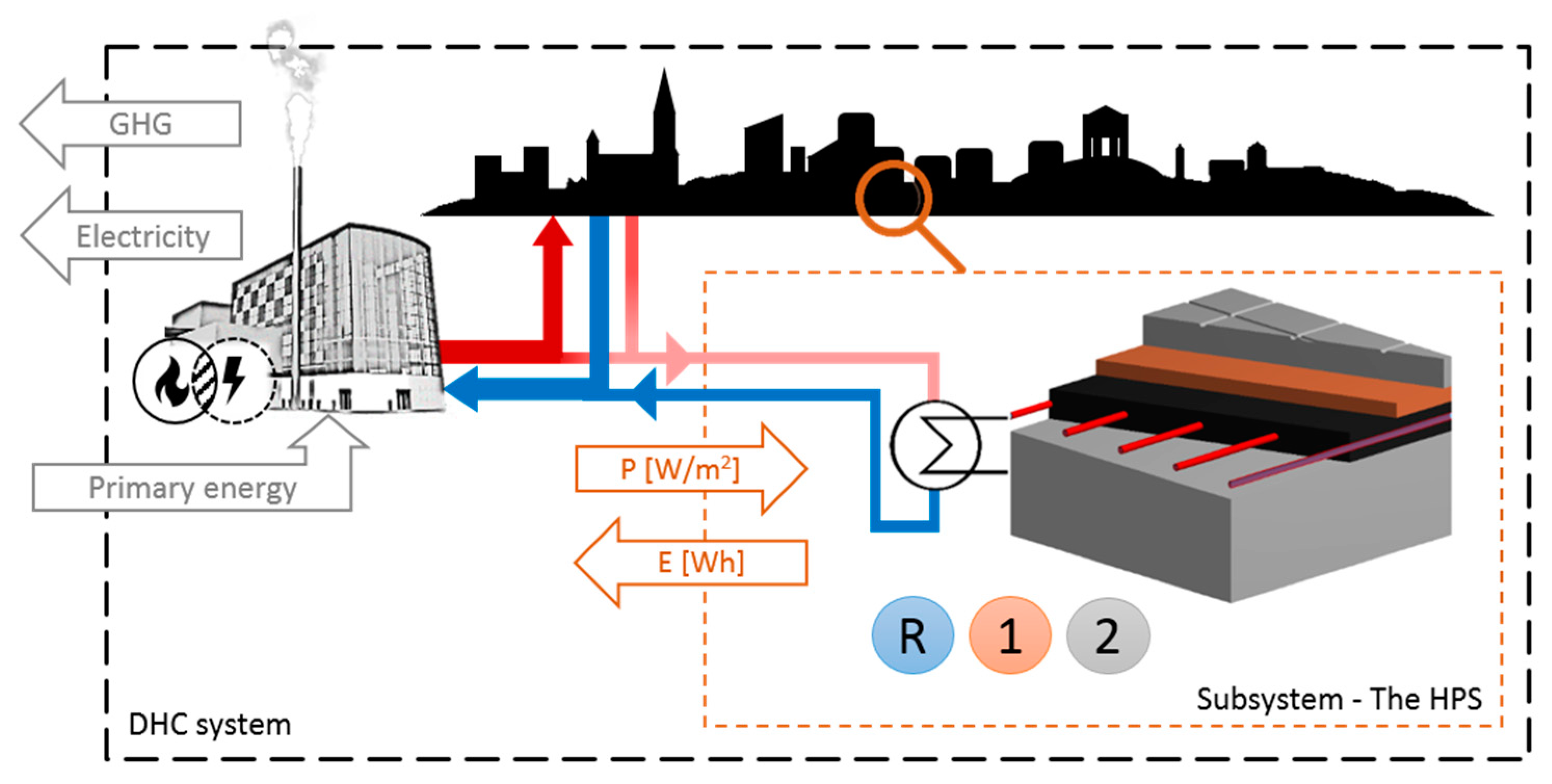
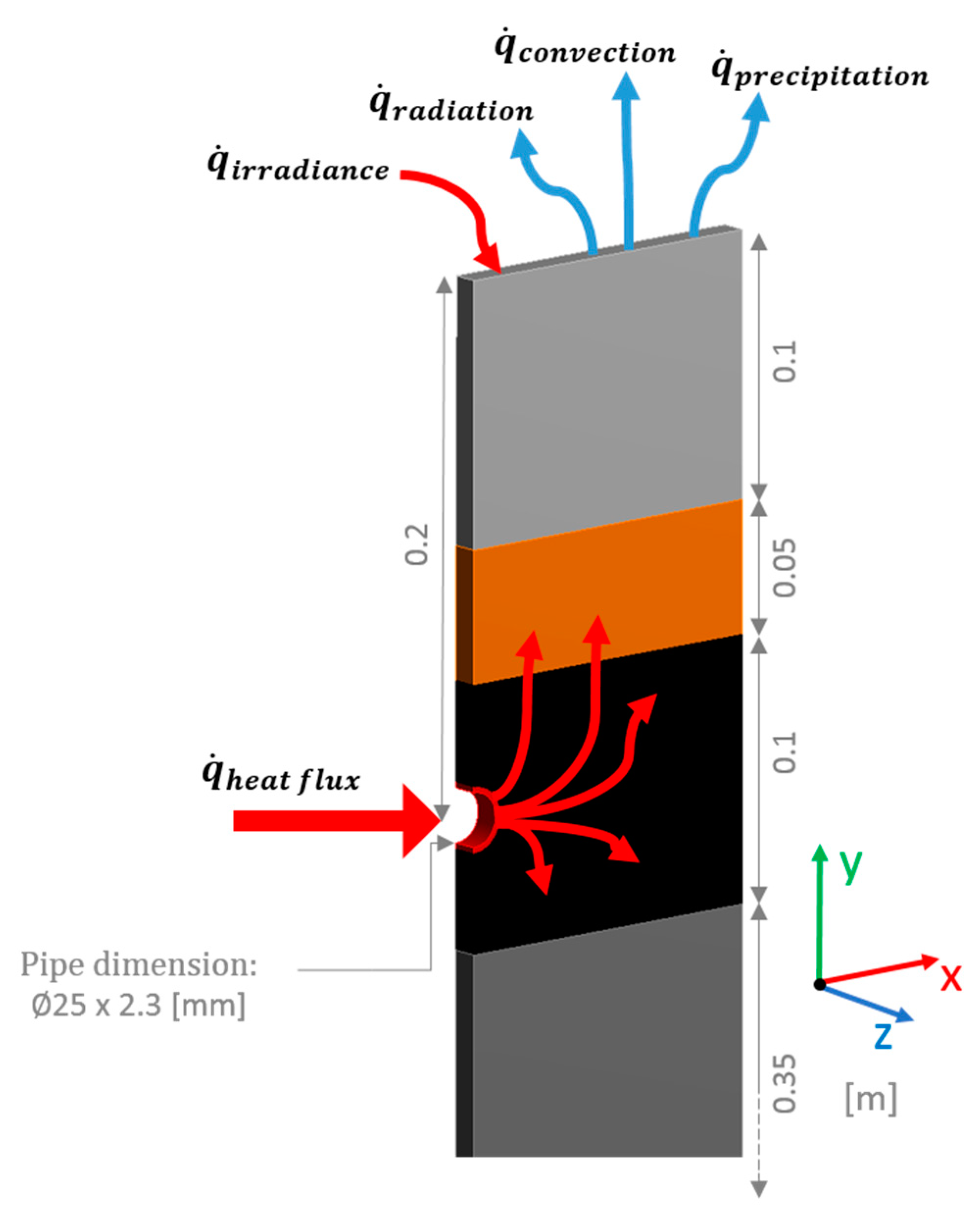
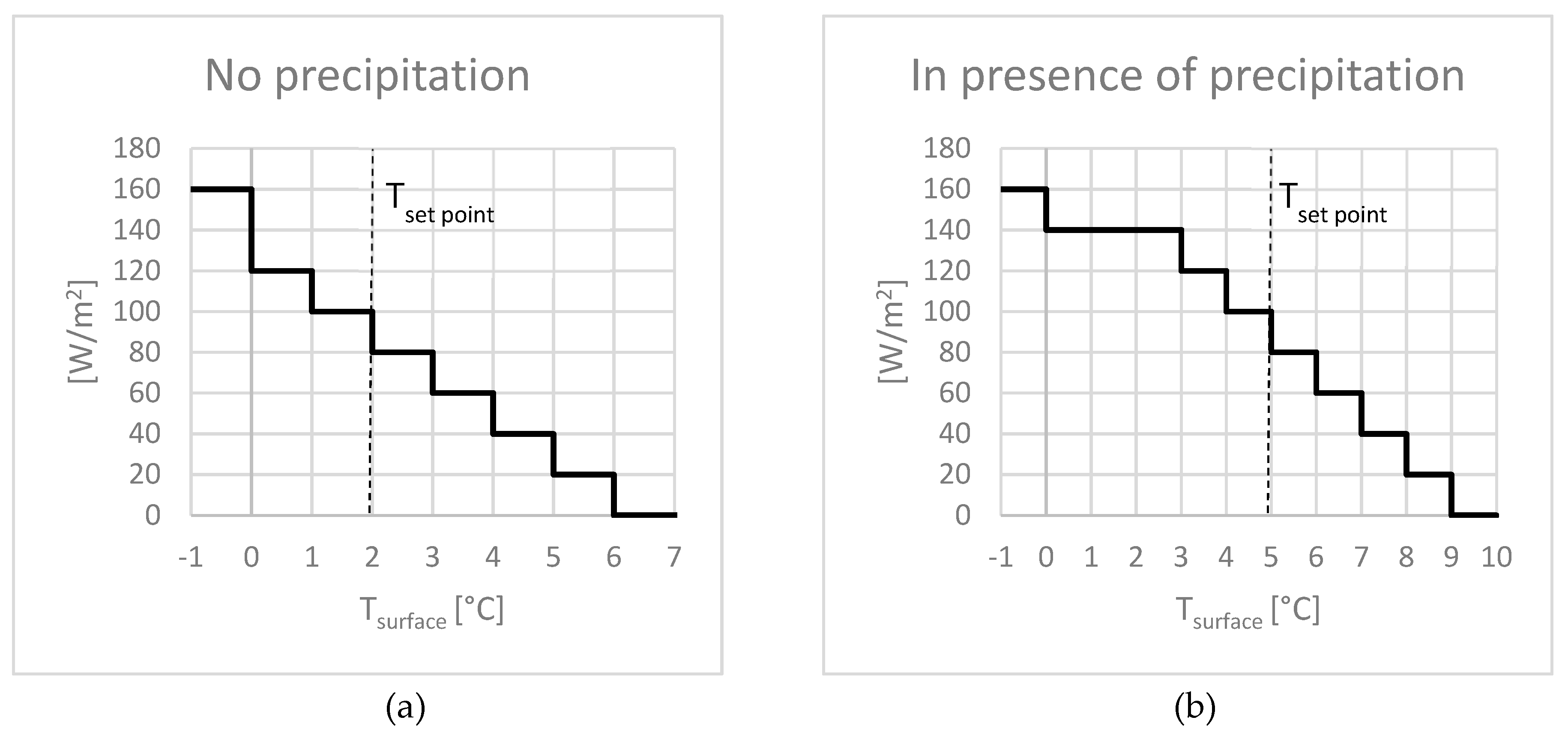

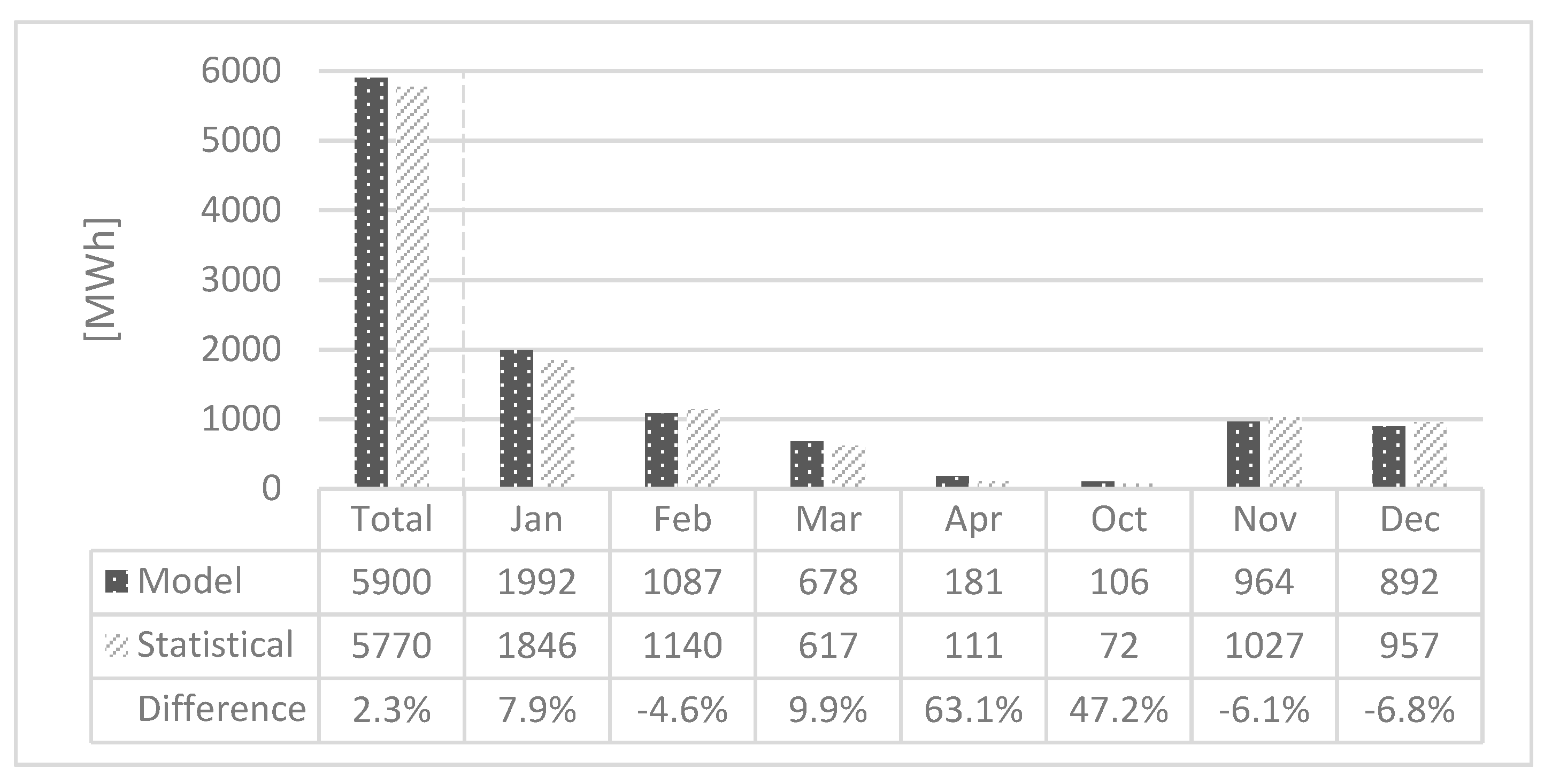
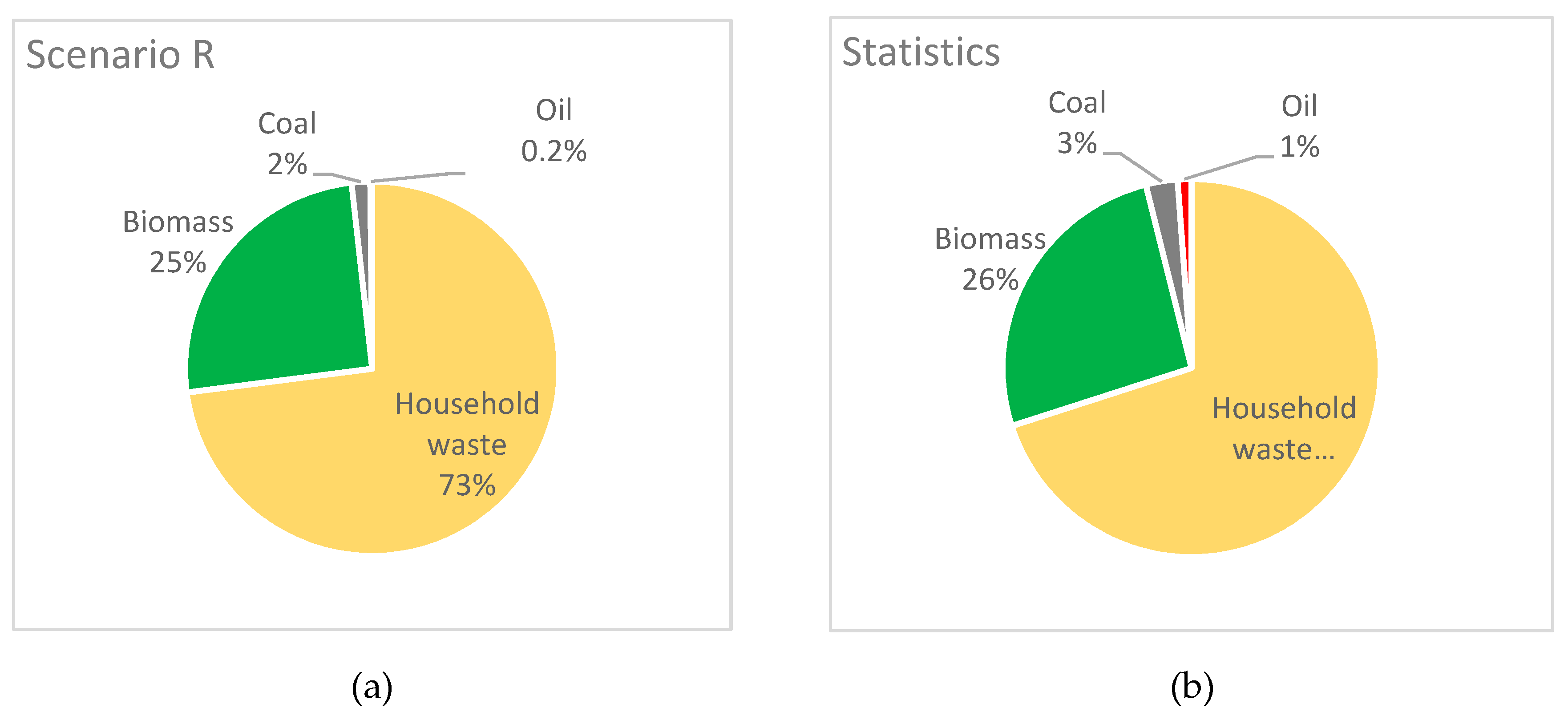
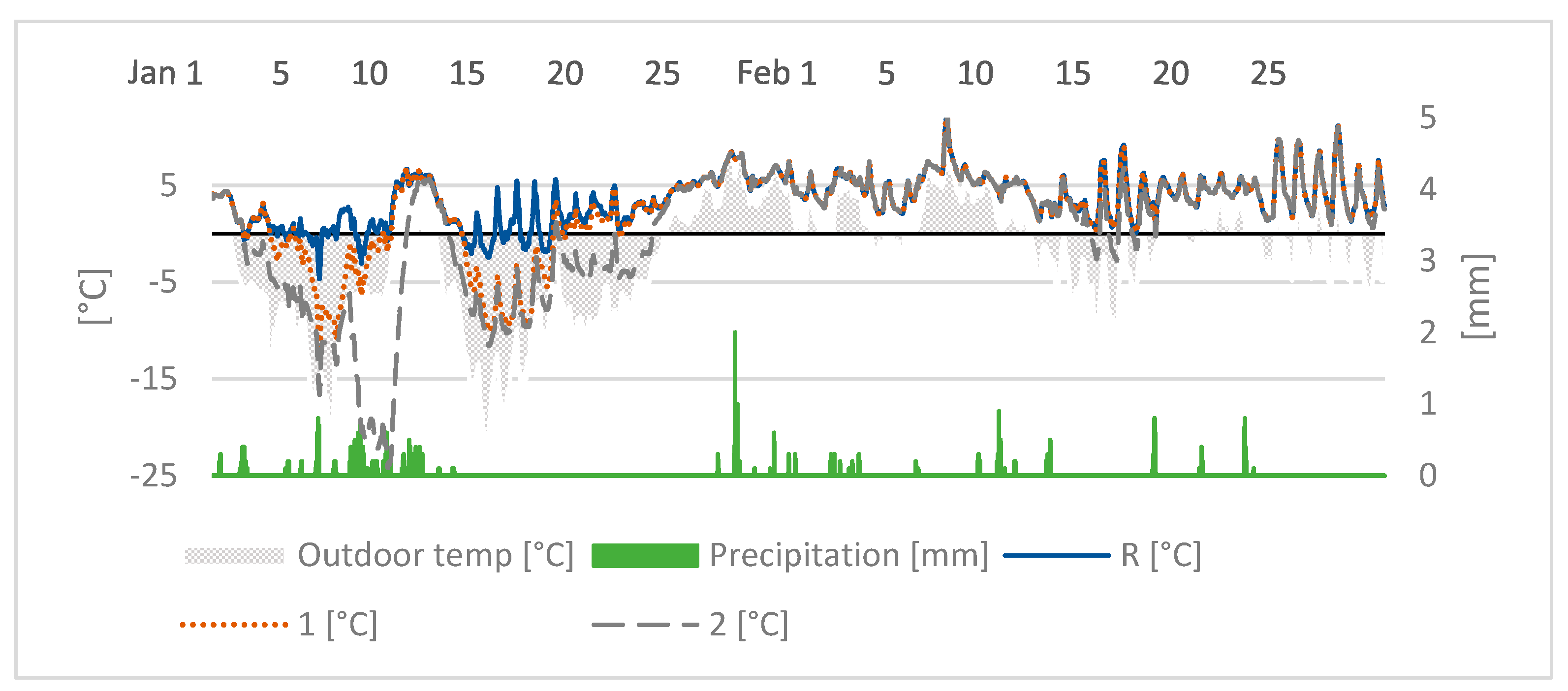
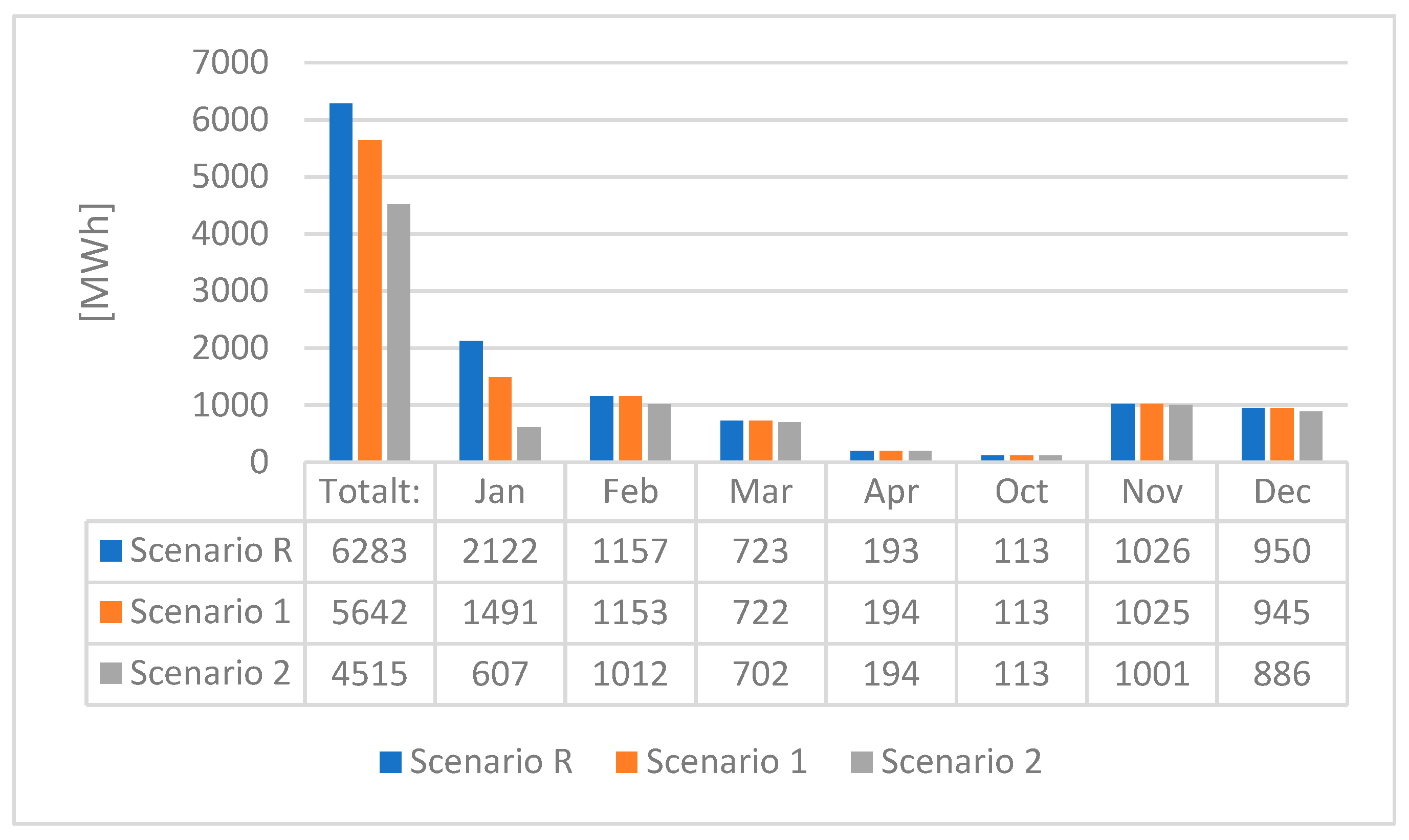
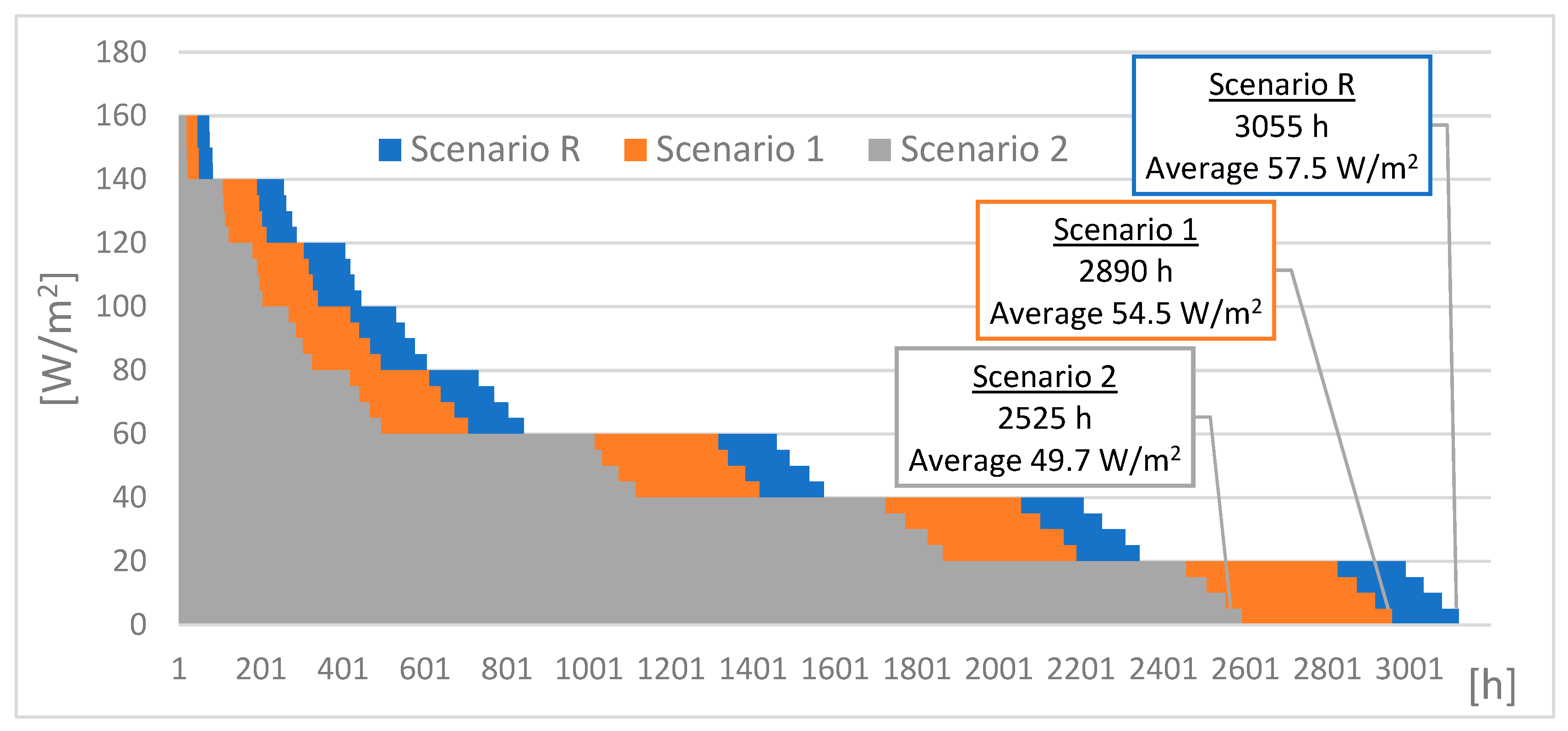
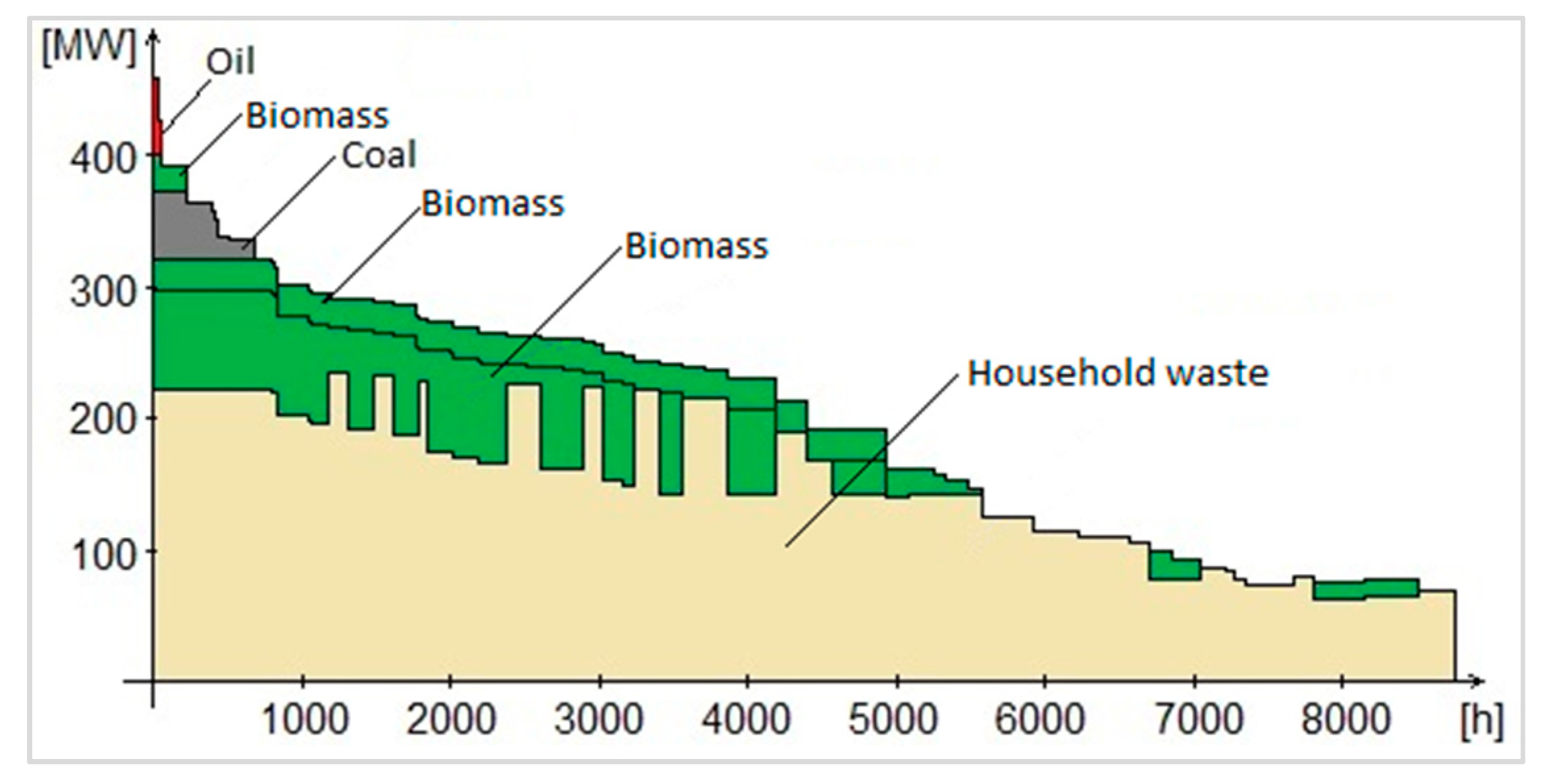
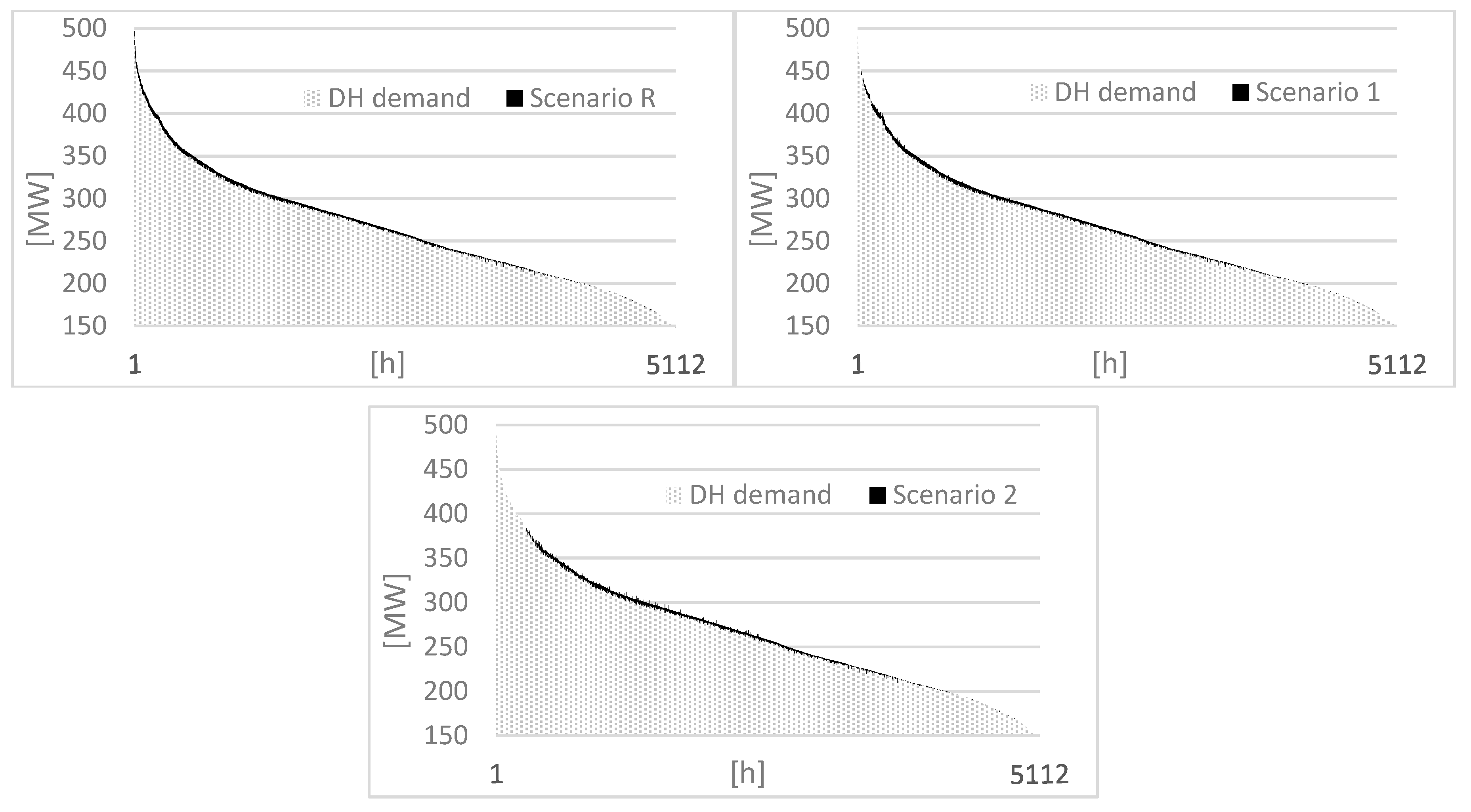
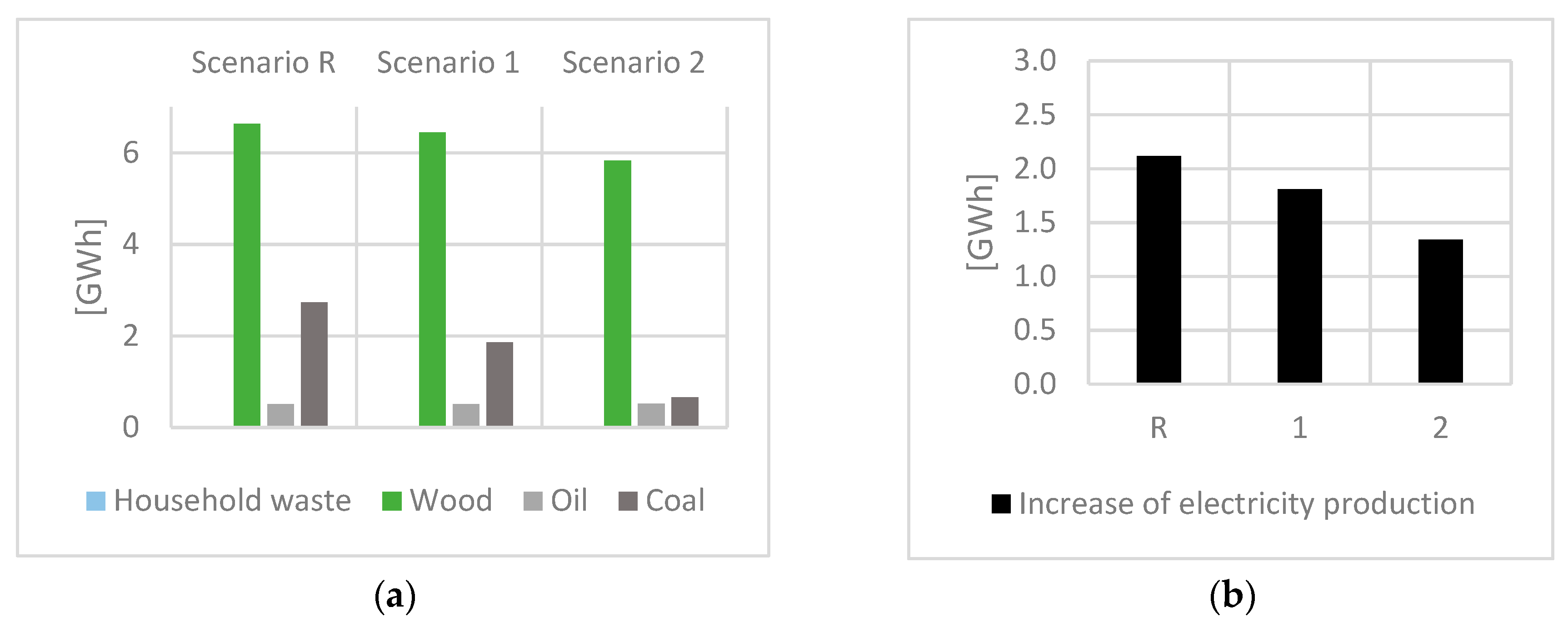
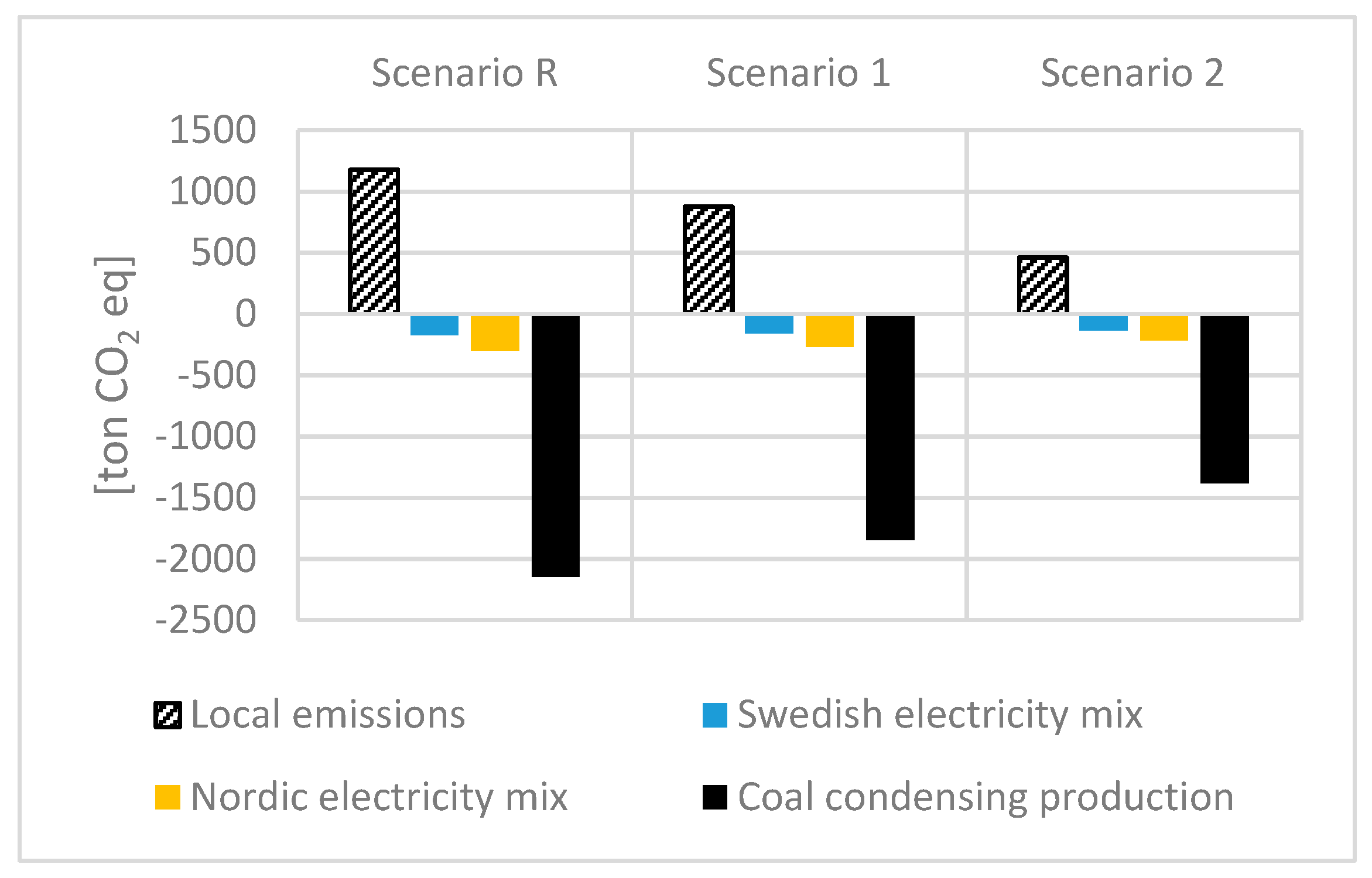
| Seasons | Months | Days and Hours | Analyzed Peak Hours |
|---|---|---|---|
| Winter | Jan–Mar, Nov–Dec | Mon–Fri 06:00–07:00 | Peak day 06:00–07:00 |
| Mon–Fri 07:00–08:00 | Peak day 07:00–08:00 | ||
| Mon–Fri 08:00–16:00 | Peak day 08:00–16:00 | ||
| Mon–Fri 16:00–22:00 | Peak day 16:00–22:00 | ||
| Mon–Fri 22:00–06:00 | Peak day 22:00–06:00 | ||
| Sat, Sun 06:00–22:00 | |||
| Sat, Sun 22:00–06:00 | |||
| Spring, summer, and autumn | Apr–Oct | Mon–Fri 06:00–22:00 | |
| Mon–Fri 22:00–06:00 | |||
| Sat, Sun 06:00–22:00 | |||
| Sat, Sun 22:00–06:00 |
| Temperature | Unit | Jan | Feb | Mar | Apr | Oct | Nov | Dec | Total |
|---|---|---|---|---|---|---|---|---|---|
| Average temp. | °C | −5 | −0.2 | 2.7 | 5.7 | 6.8 | 1.8 | 2.0 | - |
| Temperature in a normal year | °C | −2.8 | −3.0 | 0.5 | 5.2 | 7.6 | 2.4 | −1.3 | - |
| Hours < 4 °C | h | 652 | 583 | 504 | 217 | 69 | 530 | 486 | 3041 |
| Hours < 0 °C | h | 494 | 346 | 144 | 51 | 3 | 223 | 230 | 1491 |
| Precipitation | |||||||||
| Amount of precipitation | mm | 26.7 | 11.8 | 20 | 27.6 | 70.8 | 37.7 | 25.6 | 220.2 |
| –with temp < 0 °C | mm | 16.7 | 4.2 | 2.2 | 0 | 0 | 4.8 | 5 | 32.9 |
| Precipitation in a normal year | mm | 41.0 | 27.1 | 33.6 | 34.2 | 46.0 | 52.2 | 46.8 | 280.2 |
| Layer | Material | ρ (kg/m3) | λ (W/m∙°C) | Cp (J/kg∙°C) | |
|---|---|---|---|---|---|
 | A | Pavement | 2300 (1906–2450) [71,72] | 2 (0.5–3.2) [71,73] | 840 (767–2000) [72] |
| B | Sand | 1700 (1677–1771) [74,75] | 1 (0.25–3) [75,76] | 1000 (919–1117) [75] | |
| C | Asphalt | 2100 (1906–2450) [77] | 0.75 (0.74–2.9) [71,77] | 920 (800–1853) [77] | |
| D | PEX-plastic | 925 [78] | 0.35 [78] | 2300 [78] | |
| E | Gravel | 2100 (1928–2129) [75] | 1.5 (0.51–1.77) [75] | 1150 (1088–1307) [75] |
| Unit | Fuel | Heat 1 (MW) | Power (MW) | Heat from Flue Gas Condensation (MW) | |
|---|---|---|---|---|---|
| Gärstad | CHP 1–3 | Household waste 2 | 75 | 10 | 15 |
| CHP 4 | Household waste 2 | 68 | 19 | 15 | |
| CHP 5 | Household waste 2 | 84 | 21 | 12 | |
| Central | CHP 1 | Coal 3 | 83 | 31 | - |
| CHP 2 | Oil | 154 | 41 | - | |
| CHP 3 | Wood 4 | 78 | 32 or 22 5 | 20 | |
| Standalone | HOB 1 | Oil | 144 | - | - |
| HOB 2 | Electricity | 25 | - | - | |
| Mjölby | CHP | Wood | 33 | 10 | - |
| HOB | Wood | 32.5 | - | - | |
| Local Emission | GHG Emission Factor [90] (g CO2eq/kWh) | Global Emission | GHG Emission Factor [91] (g CO2eq/kWh) |
|---|---|---|---|
| Household waste | 143 | Swedish electricity mix | 36.4 |
| Wood 1 | 14.5 | Nordic electricity mix | 97.3 |
| Oil | 297 | Coal condensing production | 968.6 |
| Coal 1 | 340 | ||
| Electricity (internal) | 0 | ||
| Flue gas cond. | 0 |
© 2019 by the authors. Licensee MDPI, Basel, Switzerland. This article is an open access article distributed under the terms and conditions of the Creative Commons Attribution (CC BY) license (http://creativecommons.org/licenses/by/4.0/).
Share and Cite
Blomqvist, S.; Amiri, S.; Rohdin, P.; Ödlund, L. Analyzing the Performance and Control of a Hydronic Pavement System in a District Heating Network. Energies 2019, 12, 2078. https://doi.org/10.3390/en12112078
Blomqvist S, Amiri S, Rohdin P, Ödlund L. Analyzing the Performance and Control of a Hydronic Pavement System in a District Heating Network. Energies. 2019; 12(11):2078. https://doi.org/10.3390/en12112078
Chicago/Turabian StyleBlomqvist, Stefan, Shahnaz Amiri, Patrik Rohdin, and Louise Ödlund. 2019. "Analyzing the Performance and Control of a Hydronic Pavement System in a District Heating Network" Energies 12, no. 11: 2078. https://doi.org/10.3390/en12112078
APA StyleBlomqvist, S., Amiri, S., Rohdin, P., & Ödlund, L. (2019). Analyzing the Performance and Control of a Hydronic Pavement System in a District Heating Network. Energies, 12(11), 2078. https://doi.org/10.3390/en12112078





